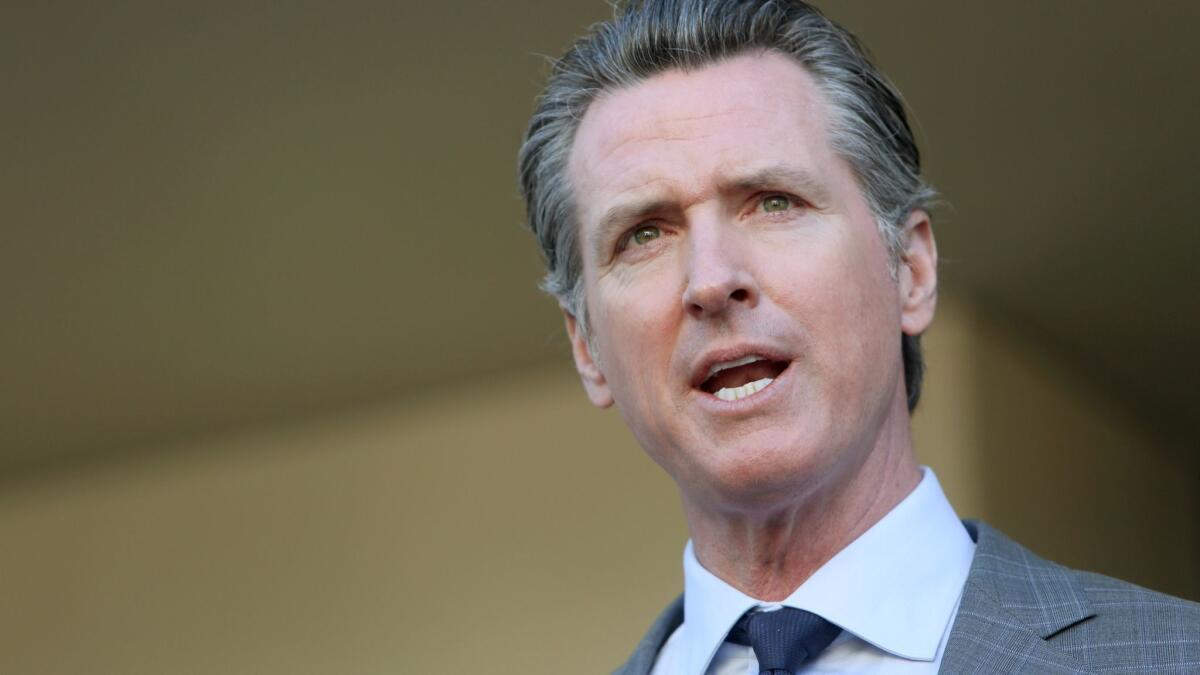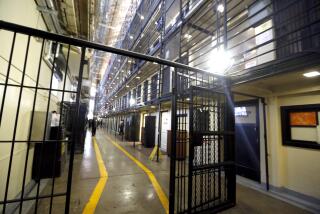Gov. Gavin Newsom to block California death row executions, close San Quentin execution chamber

Gov. Gavin Newsom will sign an executive order on Wednesday to impose a moratorium on the death penalty in California, vowing that no prisoner in the state will be executed while he is in office because of a belief that capital punishment is discriminatory, unjust and “inconsistent with our bedrock values.”
The order will prevent the state from putting prisoners to death by granting temporary reprieves to all 737 condemned inmates on California’s death row, the largest in the nation. It will immediately close the execution chamber at San Quentin State Prison and scuttle the state’s ongoing efforts to devise a constitutional method for lethal injection. No inmate will be released and no sentence or conviction will be altered, the order says.
Newsom joins governors in Oregon, Colorado and Pennsylvania who have imposed moratoriums on executions in those states, all using executive powers.
The action runs counter to the expressed will of California voters, who over the last six years rejected two statewide ballot measures to repeal the death penalty and favored fast-tracking the appeals process.
“Our death penalty system has been — by any measure — a failure,” Newsom says in prepared remarks he is expected to deliver at a Capitol news conference Wednesday morning. “It has discriminated against defendants who are mentally ill, black and brown, or can’t afford expensive legal representation. It has provided no public safety benefit or value as a deterrent. It has wasted billions of taxpayer dollars.”
Newsom also argues in his remarks that the criminal justice system is susceptible to error, citing a November Los Angeles Times editorial that reported 164 condemned prisoners nationwide who were wrongly convicted have been freed from death row since 1973. He also cites a 2005 Santa Clara University Law Review study that concluded people convicted of killing whites were more likely to be sentenced to death than people convicted of killing blacks and Latinos.
The executive order is likely to trigger legal challenges by pro-death penalty organizations and county prosecutors who have been forceful advocates for capital punishment in California. In February, the association representing deputy district attorneys in Los Angeles County accused California’s elected officials of foot-dragging on enforcing the death penalty because they “smugly substitute their own values over the ratified votes of the majority.”
Kent Scheidegger, legal director of the pro-death penalty Criminal Justice Legal Foundation, called Newsom’s actions “an abuse of power.” Although Newsom has the constitutional authority to grant reprieves to condemned inmates, he does not have the power to order the state Department of Corrections and Rehabilitation to shutter the death chamber or halt efforts to establish a lethal injection protocol, Scheidegger said.
California law requires corrections officials to maintain the ability to carry out executions, he added.
“He’s following in the footsteps of other governors who abused this power because they were frustrated by a law that they just personally disagreed with,” Scheidegger said.
The moratorium is just the latest of Newsom’s efforts to deliver on the bold, liberal agenda that defined his successful 2018 gubernatorial campaign and helped him emerge as one of President Trump’s main political foils.
On his first day in office, the former lieutenant governor and San Francisco mayor outlined a dramatic Medi-Cal expansion that would cover young immigrant adults who are in the U.S. illegally and later promised a major expansion of paid family leave in California. Newsom’s first proposed budget included a $1-billion “working families tax credit,” more than double the size of the state’s existing tax break for low-income workers, and set aside $500 million to help local governments build shelters and add services to help the homeless.
California has not executed a prisoner since 2006 because of a series of legal challenges to its method of lethal injection. But Newsom said he believed those court cases would be resolved while he was in office, clearing the way for executions to resume. The governor promised to be as “proactive” on the death penalty as he was on the issue of gay marriage, when, as mayor of San Francisco, he ordered the city to issue same-sex marriage licenses in 2004, a catalyst in a legal battle that ended when the U.S. Supreme Court affirmed the right of LGBTQ people to marry in 2015.
With 24 inmates on death row who have exhausted their appeals, Newsom in February said he feared California could potentially execute “more prisoners than any other state in modern history” if no action was taken.
California has executed 13 people since the U.S. Supreme Court reinstated the death penalty in 1976. During that same time, 79 death row inmates have died of natural causes and 26 have died by suicide, according to the California Department of Corrections and Rehabilitation.
“I do not believe that a civilized society can claim to be a leader in the world as long as its government continues to sanction the premeditated and discriminatory execution of its people,” Newsom says in his prepared remarks. “In short, the death penalty is inconsistent with our bedrock values and strikes at the very heart of what it means to be a Californian.”
Though the death penalty never emerged as a major issue in the 2018 governor’s race, Newsom has been outspoken about his opposition to capital punishment. The governor endorsed failed ballot measures in 2012 and 2016 that would have abolished the death penalty in California. Newsom also opposed a separate statewide ballot measure in 2016, Proposition 66, to accelerate the appeals process in capital cases, which California voters narrowly approved.
Shortly after his election in November, Newsom directed his legal advisors to assess his options as California’s chief executive, which include the constitutional power to commute death sentences and issue temporary reprieves.
To impose a de facto moratorium on capital punishment in California, Newsom will grant reprieves to all death row inmates that will stay in place throughout his time as governor. But the reprieves will expire as soon as Newsom leaves office, pushing the life-and-death decisions to his successor.
Newsom also has authority to commute sentences to life in prison for condemned inmates convicted of a single felony. But the governor cannot commute the sentences of prisoners convicted of two separate felonies — a population that includes more than half the inmates on death row — without the approval of the California Supreme Court.
The court rejected 10 commutations handed out by Gov. Jerry Brown in his last full month in office — all of which involved people convicted of multiple felonies — and did not provide an explanation for the action.
It was the first time in decades that California’s top court rejected a governor’s commutations, which should serve as a warning to Newsom, Scheidegger said.
Scheidegger’s organization was one of the main proponents of the successful 2016 ballot measure to fast-track executions in California, which passed by a margin of just 2 percentage points. In that same election, a competing ballot measure to repeal the death penalty and commute sentences to life in prison, Proposition 62, failed by just over 6 percentage points.
Newsom first signaled his possible intentions regarding the death penalty in February when he signed an executive order for new DNA tests in the quadruple-murder case of death row inmate Kevin Cooper, who was sentenced to death in 1985 after he was convicted of killing Doug and Peggy Ryen and their 10-year-old daughter, Jessica, as well 11-year-old Christopher Hughes, who was unrelated to the family. They were found stabbed to death in a Chino Hills home.
Newsom’s executive order came after Cooper’s attorneys alleged that key pieces of evidence were not properly tested and needed to be analyzed with modern technology.
“Especially in cases where the government seeks to impose the ultimate punishment of death, I need to be satisfied that all relevant evidence is carefully and fairly examined,” Newsom said.
Twitter: @philwillon
More to Read
Get the L.A. Times Politics newsletter
Deeply reported insights into legislation, politics and policy from Sacramento, Washington and beyond. In your inbox three times per week.
You may occasionally receive promotional content from the Los Angeles Times.







